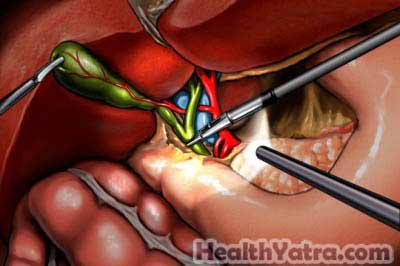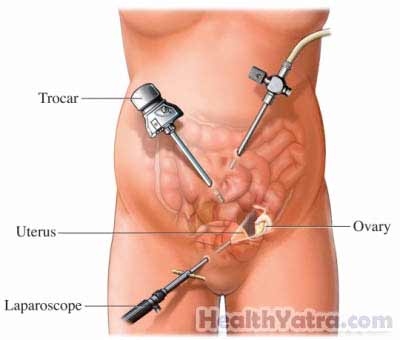تعريف
For this type of surgery, a doctor uses robotic arms to operate through small keyhole incisions in the abdomen.
The robotic arms are able to do surgical tasks with an increased range of motion. They also can filter out hand tremor. The special tools translate the doctor’s larger hand movements into smaller ones. This allows delicate work in small spaces.

أسباب هذا الإجراء
Some laparoscopic surgeries that have been successful using robotic techniques include:
- Adrenalectomy —removal of adrenal gland
- Appendectomy —removal of the appendix
- Bariatric surgery —surgery of the stomach to treat obesity
- Cholecystectomy —removal of the gallbladder
- Colorectal procedures
- Hernia repair
- Nephrectomy —removal of a kidney
- Nissen fundoplication —surgical reinforcement of the valve between the esophagus and stomach
- Prostatectomy —removal of the prostate
- Hysterectomy —removal of the uterus (results in infertility)
- Myomectomy —removal of fibroids (noncancerous tumors in the walls of the uterus)
Compared to more traditional procedures, robotic-assisted laparoscopic surgery may result in:
- Less scarring
- Reduced recovery times
- Less خطر العدوى
- Less blood loss
- Reduced trauma to the body
- Shorter hospital stay
- Faster recovery
المضاعفات المحتملة
Complications are rare, but no procedure is completely free of risk. If you are planning to have a robot-assisted laparoscopic procedure, your سيقوم الطبيب بمراجعة القائمة من المضاعفات المحتملة، والتي قد تشمل:
- Damage to neighboring organs or structures
- العدوى
- نزيف
- المشاكل المتعلقة بالتخدير
- The need to switch to traditional surgical methods (eg, traditional laparoscopic or open surgery)
بعض العوامل التي قد تزيد من خطر المضاعفات تشمل:
تشمل العوامل التي قد تزيد من خطر حدوث مضاعفات ما يلي:
- التدخين
- Pre-existing heart or lung condition
- السمنة
- مرض السكري
- الإفراط في تناول الكحول
- Previous abdominal or pelvic surgery
- Use of certain medicines
تأكد من مناقشة هذه المخاطر مع طبيبك قبل الإجراء.
ما يمكن توقعه
قبل الإجراء
Depending on the reason for your surgery, your doctor may do the following:
- اختبار بدني
- تحاليل الدم
- اختبارات البول
- Electrocardiogram (ECG, EKG) —a test that records the electrical currents passing through the heart muscle
- Intravenous pyelogram (IVP) —a type of x-ray that creates images of the kidney, ureters, and bladder by injecting dye into the bloodstream
- Kidneys, ureter, bladder (KUB) —an x-ray of the abdomen
- Abdominal or pelvic ultrasound —a test that uses sound waves to visualize the inside of the body
- CT scan —a type of x-ray that uses a computer to create images of structures inside the abdomen or pelvis
قبل الإجراء:
- التحدث مع طبيبك عن الأدوية الخاصة بك. قد يطلب منك التوقف عن تناول بعض الأدوية تصل إلى أسبوع واحد قبل العملية مثل:
- الأدوية المضادة للالتهابات (مثل الأسبرين)
- Blood thinners such as clopidogrel (Plavix) or warfarin (Coumadin)
- Take antibiotics if instructed.
- Take a laxative and/or use an enema to clean out your intestines if instructed.
- Follow a special diet if instructed.
- Shower the night before using antibacterial soap if instructed.
- Arrange for someone to drive you home from the hospital. Also, have someone to help you at home.
- تناول وجبة خفيفة في الليلة السابقة. لا تأكل أو تشرب أي شيء بعد منتصف الليل.
التخدير
Depending on the type of procedure that you have, you may be given:
- General anesthesia —blocks pain and keeps you asleep through the surgery
- Local anesthesia—just the area that is being operated on is numbed; given as an injection and may also be given with a sedative
وصف الإجراء
Several small incisions will be made. They are called keyhole incisions. Carbon dioxide gas will be passed into the abdomen to expand it. This will make it easier for the doctor to see.
A small camera will be passed through one of the incisions. This tool is called an endoscope. It lights, magnifies, and projects an image of the organs onto a video screen. The endoscope will be attached to one of the robotic arms. The other arms will hold tools that are able to grasp, cut, dissect, and suture. These may include:
- Forceps
- Scissors
- Dissectors
- Scalpels

The doctor will sit at a console, looking at the images on the screen. Joystick-like hand controls and foot pedals will help to guide the tools. Another doctor will stay by you to adjust the tools as needed. In some cases, organs or tissue might need to be removed. When the procedure is done, the tools will be removed. The doctor will close the incisions with sutures or staples and apply a sterile dressing.
كم من الوقت سيستغرق ؟
About 1-2 hours (depending on the type of procedure)
كم هو مؤلم ؟
You will have pain and discomfort during recovery. Your doctor will give you pain medicine. You may also feel bloated or have pain in your shoulder from the gas used during the procedure. This can last up to three days.
متوسط الإقامة في المستشفى
This procedure is done in a hospital setting. The usual length of stay is 1-2 days. Your doctor may choose to keep you longer if you have any problems.
رعاية ما بعد العملية
When you return home, do the following to help ensure a smooth recovery:
- Wash the incisions with mild soap and water.
- اسأل طبيبك حول, عندما هي آمنة للاستحمام, السباحة, أو نقع في الماء.
- Take antibiotics to help prevent infection if instructed.
- Avoid certain medicines.
- Resume normal activities (eg, daily walks) soon. This will promote healing. You will have to avoid other activities, like driving, sexual activity, and strenuous exercise.
- Gradually progress from a liquid to a solid diet.
- To avoid constipation:
- Eat a high-fiber diet.
- اشرب الكثير من الماء.
- Use stool softeners.
- تأكد من اتباع تعليمات طبيبك.
Depending on the procedure, you should make a full recovery within a few weeks.
استدعاء الطبيب
بعد مغادرة المستشفى، اتصل بطبيبك في حالة حدوث أي مما يلي:
- علامات الإصابة, بما في ذلك حمى وقشعريرة
- Redness, swelling, increasing pain, excessive bleeding, or discharge from an incision site
- Abdominal swelling or pain
- الغثيان أو القيء الشديد
- Persistent diarrhea or constipation
- Blood in the stool
- ألم و/أو تورم في قدميك، أو ساقيك، أو ساقيك
- سعال وضيق في التنفس وألم في الصدر
- Difficulty urinating, such as pain, burning, urgency, frequency, or persistent bleeding
- Being unable to eat or drink liquids
- Headache, feeling faint or dizzy
- Excessive vaginal bleeding (soaking more than one pad per hour) after a gynecologic procedure
- Persistent or foul smelling vaginal discharge after a gynecologic procedure
- Other worrisome symptoms
في حالة الطوارئ ، اتصل على المساعدة الطبية على الفور.
